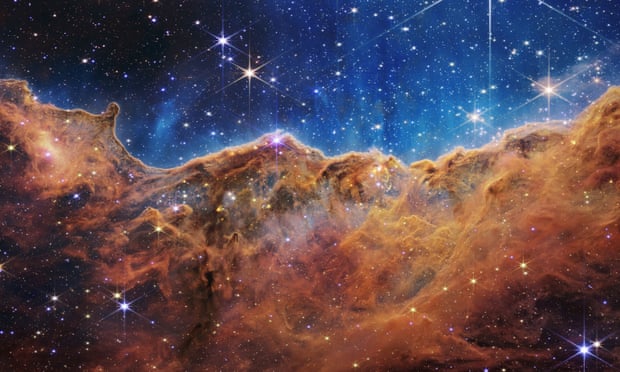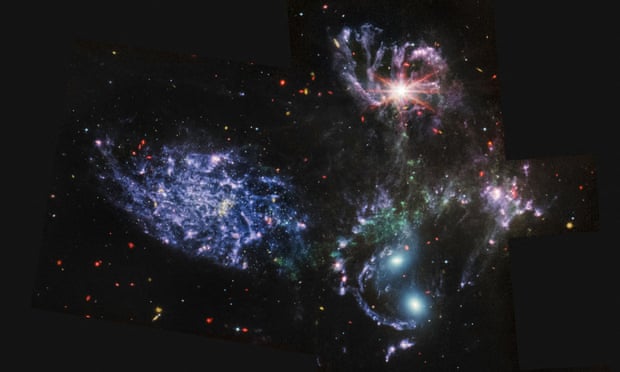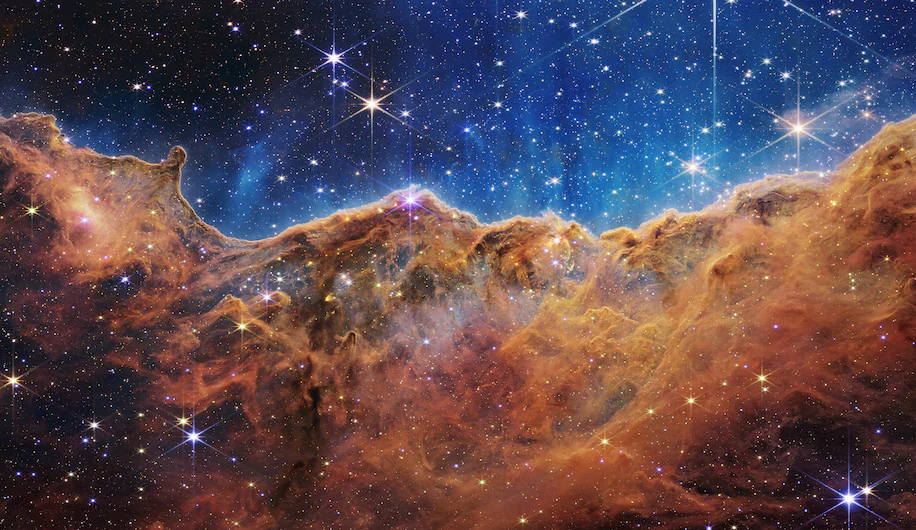Article by Monica Grady, Professor of Planetary and Space Sciences at the Open University and Chancellor of Liverpool Hope University – Published in The Guardian 17th July 2022
The inspirational JWST is pushing the limits of how far back in time cosmologists can see

Handout of the first image from the James Webb space telescope of the Carina Nebula. Photograph: NASA/PASun 17 Jul 2022 07.30 BSTLast modified on Sun 17 Jul 2022 10.22 BST
On Tuesday afternoon, we were treated to some of the most detailed images of the universe that anyone has ever seen. The pictures were the first to be released from the James Webb space telescope (JWST) and were greeted with joy by astronomers and journalists. The former because the images demonstrated that the telescope was working and the latter because the pictures would be much more pleasing to view on a newspaper’s front page than the candidates for leadership of the Conservative party.
The first images are, literally, wonderful. Specialist astronomers can see details of the birth and death of stars, as well as all the stages in between; and witness gravitational lensing, predicted by Einstein, previously only partially recorded by the JWST’s predecessor, the Hubble space telescope (HST). They continue to rhapsodise about the number and diversity of exoplanets – planets outside the solar system – that the JWST should find, and how instruments on the telescope will be able to detect and analyse exoplanetary atmospheres. The first signature of life on a planet beyond the solar system might be recorded by the JWST.
These discoveries are important and hugely significant – for astronomers and astrophysicists. But how important is the JWST for the much greater number of people for whom the closest they get to the study of stars is a daily read of their horoscope? It is true that increasing the sum of human knowledge is a Good Thing. And that understanding the origin of the universe and the potential for life beyond Earth are questions that drive many scientists (myself included). But is the £8.4bn price tag worth it? What might come from the JWST that benefits us all?
For a start, there is the inspirational value of the images. The simple joy in appreciating their beauty. The colour and texture of the pictures we have seen bring to (my) mind works by some of the finest artists. What would Turner or Monet have been moved to paint if they could have seen the JWST’s shot of the Carina Nebula? How might contemporary artists, including poets and musicians, be inspired by the JWST, enriching all of us with their interpretations?
There are, though, more practical benefits that have already come from the telescope. The real heroes in the JWST story are not the scientists who will interpret the results. Not even the instrument specialists who designed and built the equipment that will detect planets, stars and galaxies. The heroes are the engineers and technologists who built the telescope. If the JWST is pushing the limits of how far back in time cosmologists can see, it has been enabled by engineers pushing at the limits of technology. And whenever technologies advance in one field, opportunities to apply those advances elsewhere inevitably follow.
What advances have (so far) been recognised from the JWST? There are at least two that have resulted from the design of the mirror, the 6.5m gold-plated array of hexagons. In simple terms, a telescope is a bucket to collect radiation – the bigger the bucket, the more radiation can be collected in a period of time. The first picture released from the JWST was of a cluster of galaxies with the less than memorable name SMACS 0723. It had taken just over 12 hours to collect – in comparison with a less distinct version of a similar region produced over several weeks by the 2.4m-wide HST. So, the bigger your bucket – or the wider your mirror – the faster you can obtain an image.

An image from the Mid-Infrared Instrument (Miri) on the James Webb space telescope shows details of Stephan’s Quintet, a visual grouping of five galaxies. Photograph: NASA/AFP/Getty Images
The mirror on the JWST is made from beryllium, a metal that is much lighter than aluminium or glass. It was fabricated as 18 hexagonally shaped plates, and it is from these plates that the first technological spin-out was recognised. The plates have to be flat. Really, really flat, as any distortion would ruin the ability of the telescope to produce useful results. And, remember, the JWST is about a million miles away from Earth, so if anything goes wrong, it cannot be fixed by physical additions to the structure.
The engineers developed an improved sensor to measure how light scattered from the front of the mirror – in effect, looking for humps and bumps in the surface that were less than the width of a human hair in size. This technology has now been implemented in the health sector, for looking for irregularities in the shape of an eye, allowing more rapid diagnosis of ocular problems. It is anticipated that the sensor will also find many other uses – such as detection of swelling in blood vessels and impurities in semi-conductors.
Second, once the JWST arrived at its designated station, the array was unfolded. Each segment had to be aligned, using tiny motors (actuators) to push them into position. Again, the precision required to align the mirrors correctly was to less than the width of a human air. Actuators are widely used in many sectors – and the design of a new generation of even smaller, automatically controlled motors has a range of applications, starting with precision-positioning of surgical instruments through to life detection in hazardous situations. There will doubtless be other benefits, and the beauty of the images will always be with us.
One final thought. It might have escaped your notice, but I have not referred to Nasa’s JWST. This is because it is not Nasa’s JWST. It was designed and built by a consortium: the European and Canadian space agencies (ESA and CSA, respectively) working alongside Nasa.
As part of our membership of ESA, the UK played a major role in the design and build of Miri, the Mid Infrared Instrument on the JWST. The UK has a thriving space industry, with government figures showing it added some £16.5bn to our economy in 2019/20 – sufficient for us to launch two JWSTs of our own. The space sector has a positive growth forecast, despite a shrinking economy, and that’s worth a lot more than any horoscope predictions about gifts from the stars.
Updated/maj. 17-07-2022
Vues : 10


